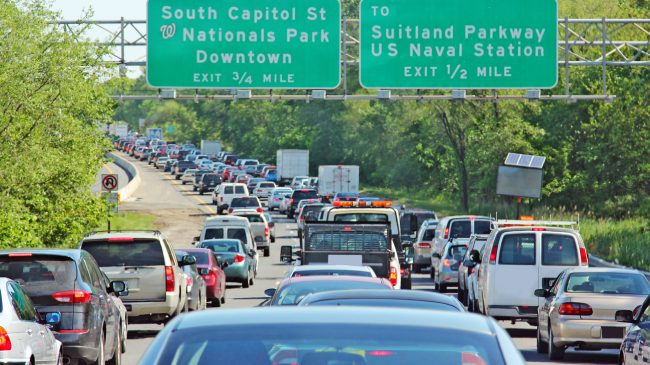Is adding freeway capacity foolish?
Many of those who oppose adding lanes to congested freeways argue that doing this is futile because the new lanes quickly fill up with cars and traffic congestion is soon back to what it was before. They increasingly cite an academic study, which they claim proved this theory, and have taken to calling it the “iron law of roadway congestion.”
In my book, Rethinking America’s Highways (University of Chicago Press, 2018), I analyzed that academic paper and found that what the researchers did prove was actually far less than highway opponents claim. Let’s take a closer look.
The paper appeared in the American Economic Review in 2011. Economists Gilles Duranton and Matthew Turner titled the paper “The Fundamental Law of Road Congestion: Evidence from U.S. Cities.”
Here is what they did: Using federal highway data plus data from the National Household Travel Survey, their econometric analysis found evidence that vehicle miles of travel (VMT) on urban Interstates increases proportionally to highway capacity. In effect, they claimed, highway supply creates its own demand.
But some people opposed to adding capacity to highways are claiming stronger results than Duranton and Turner’s analysis produced—a purported one-for-one correlation (always and everywhere) between highway capacity growth and VMT growth.
Here are some of the limitations with what Duranton and Turner did. First, their detailed analysis deals only with urban Interstates. Analytically, they treat parallel arterials and all other roadways in the metro area as a large blob. That leaves them unable to analyze (as opposed to only speculating about) the extent to which drivers shift trips from parallel arterials to the newly expanded urban Interstate (which would not represent new driving, but simply a re-allocation of existing driving).
Second, the authors’ premise that all such freeways have a “natural level of saturation” implies that all urban Interstates should fill up to the point of serious peak-period congestion. But in fact, actual congestion levels (in both extent and duration) vary considerably among the set of a metro area’s freeways. And the extent of congestion also varies enormously among large metro areas overall. In 2014, Randal O’Toole’s Antiplanner blog provided data on daily VMT per lane-mile on urban freeways around the country, finding a range from as low as 9,000 to a high of 22,000.
Third, since most metro areas in recent decades have added relatively little freeway capacity, the authors’ analytical results, even if correct, would tell us only that making marginal increases in freeway capacity produces little in the way of freeway congestion reduction. In fact, the relatively small number of urban areas that have made much larger than average capacity additions have had considerably less congestion thereafter than the majority that has done so only in incremental additions. Exhibit 13 in the 2012 Urban Mobility Report from the Texas AandM Transportation Institute is a graph showing that, compared to the 84 urban areas that have made only modest capacity additions, the 17 that have kept capacity growth to within 10 percent of VMT growth have (on average) experienced decreasing congestion since 1997. Duranton and Turner’s methodology does not capture differences of this kind.
O’Toole also provided data showing significant differences among the 30 largest metro areas (for the same time periods Duranton and Turner cover) in the relationship between capacity expansion and VMT growth. If the contention that the elasticity between capacity increase and VMT increase is always close to 1.0, those large elasticity variations among congested urban areas would not exist.
Commuting expert Alan Pisarski provided some additional perspective in a 2014 presentation on this subject. Supposing that some version of Duranton and Turner’s “fundamental law” were correct, does the “futility” conclusion of the anti-highway people follow?
Pisarski suggests looking at why more motorists show up on the expanded freeway: some switch from parallel routes because they find the expanded freeway an improvement over their former route. Those who shift from other travel times do this because it increases their utility to be able to drive at that hour. And the same goes for those who shift from other modes, such as transit. Hence, the expanded freeway “improves and expands choice for both previous and new users.”
This gets back to the question of how a highway provider should respond to increased demand from its customers. Should it tell the customers they are wrong to prefer personal mobility? Should an electric utility tell its customers they should switch to wood-burning stoves, rather than adding generating capacity? Should a school district not add schools to serve a growing population of families with kids?
Infrastructure providers are supposed to provide the vital facilities that people are willing to pay for, not tell them their preferences are wrong.
To be sure, there are locations where the cost of adding freeway capacity may significantly exceed the benefits to highway customers. When that is the case, I agree with Duranton and Turner that the solution is to implement congestion pricing. And in some of those cases, the additional revenue from pricing may be high enough to make the capacity addition feasible.
Most recently, the “iron law” claim is being raised in opposition to plans to add priced express toll lanes to congested freeways, such as the Maryland half of the I-495 Beltway around the Washington, DC, metro area. This kind of capacity addition is the kind the authors of the “iron law” would very likely approve, so it is especially misleading to invoke their study to argue against such projects.

